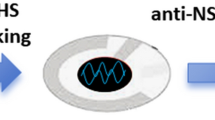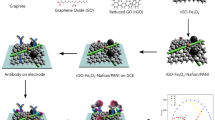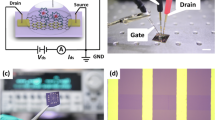Abstract
Here, we present an electrochemical biosensor for sensitive, specific, and rapid detection of lung cancer biomarker, neuron-specific enolase by utilization of rGO-modified r-MoS2 multi-layered nanosheets as a matrix. Layered structures along with the synergetic effect of r-MoS2 and rGO allow easy grafting of two materials into one another. This empowers the sensor to have a heterogeneous rate transfer constant of 1.29 × 10–3 cm/s and an electroactive surface area of 27.83 mm2. Electrochemical impedance spectroscopy and cyclic voltammetry are used as dual modes for the detection of NSE, and the sensor exhibits a wide linear detection range. The sensor is found to be reproducible with a relative standard deviation of less than 5% along with an invariant response towards other endogenous interfering species found in human serum. The investigations done in this study will further help us to fabricate a device for rapid and early detection of lung cancer.
Graphical abstract
Drop casting of lung cancer biomarker (NSE) onto BSA/anti-NSE/r-MoS2-rGO/ITO bioelectrode and its electrochemical response using EIS and CV.










Similar content being viewed by others
Data availability
Data related to the manuscript content will be made available upon request.
References
F. Bray, J. Ferlay, I. Soerjomataram, R.L. Siegel, L.A. Torre, A. Jemal, Global cancer statistics 2018: GLOBOCAN estimates of incidence and mortality worldwide for 36 cancers in 185 countries. CA: A Cancer J Clin 68(6), 394 (2018)
H. Singh, J. Bernabe, J. Chern, M.J.J.M.R. Nath, Copper selenide as multifunctional non-enzymatic glucose and dopamine sensor. J. Mater. Res. 36(7), 1413–1424 (2021)
H. Wang, S. Wu, T. Cao, B. Zhao, J. Ruan, J. Cao, Z. Tong, X.J.J.M.R. Zhang, Self-assembly behavior of layered titanium niobate and methylene blue cation and electrochemical detection of dopamine. J. Mater. Sci. 36, 1437 (2021)
J. Han, Y. Zhuo, Y.-Q. Chai, Y.-L. Yuan, R. Yuan, Novel electrochemical catalysis as signal amplified strategy for label-free detection of neuron-specific enolase. Biosens. Bioelectron. 31(1), 399 (2012)
G. Yang, Z. Xiao, C. Tang, Y. Deng, H. Huang, Z. He, Recent advances in biosensor for detection of lung cancer biomarkers. Biosens. Bioelectron. 141, 111416 (2019)
D. Carney, D. Ihde, M. Cohen, P. Marangos, P. Bunn Jr., J. Minna, A.J.T.L. Gazdar, Serum neuron-specific enolase: a marker for disease extent and response to therapy of small-cell lung cancer. The Lancet 319(8272), 583 (1982)
C.-M. Xu, Y.-L. Luo, S. Li, Z.-X. Li, L. Jiang, G.-X. Zhang, L. Owusu, H.-L.J.B. Chen, Multifunctional neuron-specific enolase: its role in lung diseases. Biosci. Rep. 39(11), BSR20192732 (2019)
A. Kalkal, S. Kadian, S. Kumar, G. Manik, P. Sen, S. Kumar, G.J.B. Packirisamy, Ti3C2-MXene decorated with nanostructured silver as a dual-energy acceptor for the fluorometric neuron specific enolase detection. Biosens. Bioelectron. 195, 113620 (2022)
S. Yin, L. Zhao, Z. Ma, Label-free electrochemical immunosensor for ultrasensitive detection of neuron-specific enolase based on enzyme-free catalytic amplification. Anal. Bioanal. Chem. 410(4), 1279 (2018)
Q. Zhang, X. Li, C. Qian, L. Dou, F. Cui, X. Chen, Label-free electrochemical immunoassay for neuron specific enolase based on 3D macroporous reduced graphene oxide/polyaniline film. Anal. Biochem. 540, 1 (2018)
H. Wang, Z. Ma, Amperometric immunoassay for the tumor marker neuron-specific enolase using a glassy carbon electrode modified with a nanocomposite consisting of polyresorcinol and of gold and platinum nanoparticles. Microchim. Acta 184(9), 3247 (2017)
X. Fu, R. Huang, J. Wang, X. Feng, Platinum nanoflower-based catalysts for an enzyme-free electrochemical immunoassay of neuron-specific enolase. Anal. Methods 5(16), 3803 (2013)
A. Mohammadi, E. Heydari-Bafrooei, M.M. Foroughi, M. Mohammadi, Electrochemical aptasensor for ultrasensitive detection of PCB77 using thionine-functionalized MoS2-rGO nanohybrid. Microchem. J. 155, 104747 (2020)
A. Sinha, B. Tan, Y. Huang, H. Zhao, X. Dang, J. Chen, R. Jain, MoS2 nanostructures for electrochemical sensing of multidisciplinary targets: a review. TrAC Trends Anal. Chem. 102, 75 (2018)
C. Anichini, W. Czepa, D. Pakulski, A. Aliprandi, A. Ciesielski, P. Samorì, Chemical sensing with 2D materials. Chem. Soc. Rev. 47(13), 4860 (2018)
K. Kalantar-zadeh, J.Z. Ou, Biosensors based on two-dimensional MoS2. Acs Sens. 1(1), 5 (2016)
V. Georgakilas, J.N. Tiwari, K.C. Kemp, J.A. Perman, A.B. Bourlinos, K.S. Kim, R. Zboril, Noncovalent functionalization of graphene and graphene oxide for energy materials, biosensing, catalytic, and biomedical applications. Chem. Rev. 116(9), 5464 (2016)
H.-H. Huang, K.K.H. De Silva, G. Kumara, M. Yoshimura, Structural evolution of hydrothermally derived reduced graphene oxide. Sci. Rep. 8(1), 1 (2018)
H. Yang, J. Zhou, J. Bao, Y. Ma, J. Zhou, C. Shen, H. Luo, M. Yang, C. Hou, D. Huo, A simple hydrothermal one-step synthesis of 3D-MoS2/rGO for the construction of sensitive enzyme-free hydrogen peroxide sensor. Microchem. J. 162, 105746 (2021)
S. Gao, Y. Zhang, Z. Yang, T. Fei, S. Liu, T.J.J.A. Zhang, Compounds: Electrochemical chloramphenicol sensors-based on trace MoS2 modified carbon nanomaterials: Insight into carbon supports. J. Alloys Compd. 872, 159687 (2021)
O. Jalil, C.M. Pandey, D.J.B. Kumar, Highly sensitive electrochemical detection of cancer biomarker based on anti-EpCAM conjugated molybdenum disulfide grafted reduced graphene oxide nanohybrid. Bioelectrochemistry 138, 107733 (2021)
R. Khatri, N.K. Puri, Electrochemical study of hydrothermally synthesised reduced MoS2 layered nanosheets. Vacuum 175, 109250 (2020)
M.A.R. Anjum, H.Y. Jeong, M.H. Lee, H.S. Shin, J.S.J.A.M. Lee, Efficient hydrogen evolution reaction catalysis in alkaline media by all-in-one MoS2 with multifunctional active sites. Adv. Mater. 30(20), 1707105 (2018)
F. Wang, M. Zheng, B. Zhang, C. Zhu, Q. Li, L. Ma, W.J.S. Shen, Ammonia intercalated flower-like MoS2 nanosheet film as electrocatalyst for high efficient and stable hydrogen evolution. Sci. Rep. 6(1), 1 (2016)
M. Li, D. Wang, J. Li, Z. Pan, H. Ma, Y. Jiang, Z.J.R. Tian, Facile hydrothermal synthesis of MoS 2 nano-sheets with controllable structures and enhanced catalytic performance for anthracene hydrogenation. RSC Adv. 6(75), 71534 (2016)
M. Sreeramareddygari, M. Somasundrum, W.J.N.J.C. Surareungchai, In situ polymerization and covalent functionalisation of trithiocyanuric acid by MoS2 nanosheets resulting in a novel nanozyme with enhanced peroxidase activity. New J Chem 44(15), 5809 (2020)
X. Xia, Z. Zheng, Y. Zhang, X. Zhao, C.J.I. Wang, Synthesis of MoS2-carbon composites with different morphologies and their application in hydrogen evolution reaction. Int. J. Hydogen Energy 39(18), 9638 (2014)
M. Li, A. Addad, Y. Zhang, A. Barras, P. Roussel, M.A. Amin, S. Szunerits, R.J.C. Boukherroub, Flower-like nitrogen-co-doped MoS2@ RGO composites with excellent stability for supercapacitors. ChemElectroChem 8(15), 2903 (2021)
H. Sun, H. Liu, Z. Hou, R. Zhou, X. Liu, J.-G.J.C.E.J. Wang, Edge-terminated MoS2 nanosheets with an expanded interlayer spacing on graphene to boost supercapacitive performance. Chem. Eng. J 387, 124204 (2020)
X. Bai, Y. Du, X. Hu, Y. He, C. He, E. Liu, J. Fan, Synergy removal of Cr (VI) and organic pollutants over RP-MoS2/rGO photocatalyst. Appl. Catal. B 239, 204 (2018)
W.-K. Jo, S. Kumar, M.A. Isaacs, A.F. Lee, S. Karthikeyan, Cobalt promoted TiO2/GO for the photocatalytic degradation of oxytetracycline and Congo Red. Appl. Catal. B 201, 159 (2017)
H. Sun, S. Liu, G. Zhou, H.M. Ang, M.O. Tadé, S. Wang, Reduced graphene oxide for catalytic oxidation of aqueous organic pollutants. ACS Appl. Mater. Interfaces. 4(10), 5466 (2012)
L. Chen, D. Ding, C. Liu, H. Cai, Y. Qu, S. Yang, Y. Gao, T. Cai, Degradation of norfloxacin by CoFe2O4-GO composite coupled with peroxymonosulfate: a comparative study and mechanistic consideration. Chem. Eng. J. 334, 273 (2018)
J. Zhou, H. Xiao, B. Zhou, F. Huang, S. Zhou, W. Xiao, D. Wang, Hierarchical MoS2–rGO nanosheets with high MoS2 loading with enhanced electro-catalytic performance. Appl. Surf. Sci. 358, 152 (2015)
S. Yang, X. Feng, S. Ivanovici, K. Müllen, Fabrication of graphene-encapsulated oxide nanoparticles: towards high-performance anode materials for lithium storage. Angew. Chem. Int. Ed. 49(45), 8408 (2010)
H. Wang, J.T. Robinson, X. Li, H. Dai, Solvothermal reduction of chemically exfoliated graphene sheets. J. Am. Chem. Soc. 131(29), 9910 (2009)
S. Stankovich, D.A. Dikin, R.D. Piner, K.A. Kohlhaas, A. Kleinhammes, Y. Jia, Y. Wu, S.T. Nguyen, R.S. Ruoff, Synthesis of graphene-based nanosheets via chemical reduction of exfoliated graphite oxide. Carbon 45(7), 1558 (2007)
J. Zhang, L. Zhao, A. Liu, X. Li, H. Wu, C. Lu, Three-dimensional MoS2/rGO hydrogel with extremely high double-layer capacitance as active catalyst for hydrogen evolution reaction. Electrochim. Acta 182, 652 (2015)
L. Lin, S. Zhang, Effective solvothermal deoxidization of graphene oxide using solid sulphur as a reducing agent. J. Mater. Chem. 22(29), 14385 (2012)
T. Yang, L.-H. Liu, J.-W. Liu, M.-L. Chen, J.-H. Wang, Cyanobacterium metallothionein decorated graphene oxide nanosheets for highly selective adsorption of ultra-trace cadmium. J. Mater. Chem. 22(41), 21909 (2012)
R. Vinoth, I.M. Patil, A. Pandikumar, B.A. Kakade, N.M. Huang, D.D. Dionysios, B. Neppolian, Synergistically enhanced electrocatalytic performance of an N-doped graphene quantum dot-decorated 3D MoS2–graphene nanohybrid for oxygen reduction reaction. ACS Omega 1(5), 971 (2016)
G. Sun, X. Zhang, R. Lin, J. Yang, H. Zhang, P. Chen, Hybrid fibers made of molybdenum disulfide, reduced graphene oxide, and multi-walled carbon nanotubes for solid-state, flexible, asymmetric supercapacitors. Angew. Chem. 127(15), 4734 (2015)
S. Kumar, V. Sharma, K. Bhattacharyya, V. Krishnan, Synergetic effect of MoS 2–RGO doping to enhance the photocatalytic performance of ZnO nanoparticles. New J. Chem. 40(6), 5185 (2016)
N. Kumar, S. Kumar, R. Gusain, N. Manyala, S. Eslava, S.S. Ray, Polypyrrole-promoted rGO–MoS2 nanocomposites for enhanced photocatalytic conversion of CO2 and H2O to CO, CH4, and H2 products. ACS Appl. Energy Mater. 3(10), 9897 (2020)
E.G. da Silveira Firmiano, A.C. Rabelo, C.J. Dalmaschio, A.N. Pinheiro, E.C. Pereira, W.H. Schreiner, E.R. Leite, Supercapacitor electrodes obtained by directly bonding 2D MoS2 on reduced graphene oxide. Adv. Energy Mater. 4(6), 1301380 (2014)
Y.-L. Chen, Z.-A. Hu, Y.-Q. Chang, H.-W. Wang, Z.-Y. Zhang, Y.-Y. Yang, H.-Y.J.T.J.P.C.C. Wu, Zinc oxide/reduced graphene oxide composites and electrochemical capacitance enhanced by homogeneous incorporation of reduced graphene oxide sheets in zinc oxide matrix. J Phys. Chem. C 115(5), 2563 (2011)
G. Wang, X. Shen, J. Yao, J.J.C. Park, Graphene nanosheets for enhanced lithium storage in lithium ion batteries. Carbon 47(8), 2049 (2009)
L. Zhang, W. Fan, W.W. Tjiu, T. Liu, 3D porous hybrids of defect-rich MoS 2/graphene nanosheets with excellent electrochemical performance as anode materials for lithium ion batteries. RSC Adv. 5(44), 34777 (2015)
V.K. Singh, S. Kumar, S.K. Pandey, S. Srivastava, M. Mishra, G. Gupta, B. Malhotra, R. Tiwari, A. Srivastava, Fabrication of sensitive bioelectrode based on atomically thin CVD grown graphene for cancer biomarker detection. Biosens. Bioelectron. 105, 173 (2018)
S. Kumar, S. Kumar, S. Tiwari, S. Srivastava, M. Srivastava, B.K. Yadav, S. Kumar, T.T. Tran, A.K. Dewan, A. Mulchandani, Biofunctionalized nanostructured zirconia for biomedical application: a smart approach for oral cancer detection. Adv. Sci. 2(8), 1500048 (2015)
M. Kukkar, A. Sharma, P. Kumar, K.-H. Kim, A. Deep, Application of MoS2 modified screen-printed electrodes for highly sensitive detection of bovine serum albumin. Anal. Chim. Acta 939, 101 (2016)
J.-B. Jorcin, M.E. Orazem, N. Pébère, B.J.E.A. Tribollet, CPE analysis by local electrochemical impedance spectroscopy. Electrochim. Acta 51(8–9), 1473 (2006)
B. Hirschorn, M.E. Orazem, B. Tribollet, V. Vivier, I. Frateur, M.J.J.T.E.S. Musiani, Constant-phase-element behavior caused by resistivity distributions in films: I. Theory 157(12), 452 (2010)
M. Farrokhnia, G. Amoabediny, M. Ebrahimi, M. Ganjali, M.J.T. Arjmand, Ultrasensitive early detection of insulin antibody employing novel electrochemical nano-biosensor based on controllable electro-fabrication process. Talanta 238, 122947 (2021)
O. Jalil, C.M. Pandey, D.J.M.A. Kumar, Electrochemical biosensor for the epithelial cancer biomarker EpCAM based on reduced graphene oxide modified with nanostructured titanium dioxide. Microchim. Acta 187(5), 1 (2020)
X. Xi, D. Wu, W. Ji, S. Zhang, W. Tang, Y. Su, X. Guo, R.J.A.F.M. Liu, Manipulating the sensitivity and selectivity of OECT-based biosensors via the surface engineering of carbon cloth gate electrodes. Adv. Funct. Mater. 30(4), 1905361 (2020)
D. Sandil, S.C. Sharma, N.K. Puri, Protein-functionalized WO 3 nanorods–based impedimetric platform for sensitive and label-free detection of a cardiac biomarker. J. Mater. Res. 34(8), 1331 (2019)
D. Chauhan, P.K. Gupta, P.R. Solanki, Electrochemical immunosensor based on magnetite nanoparticles incorporated electrospun polyacrylonitrile nanofibers for Vitamin-D3 detection. Mater. Sci. Eng. C 93, 145 (2018)
S. Kumar, N. Gupta, B.D. Malhotra, Ultrasensitive biosensing platform based on yttria doped zirconia-reduced graphene oxide nanocomposite for detection of salivary oral cancer biomarker. Bioelectrochemistry 140, 107799 (2021)
D.C. Marcano, D.V. Kosynkin, J.M. Berlin, A. Sinitskii, Z. Sun, A. Slesarev, L.B. Alemany, W. Lu, J.M. Tour, Improved synthesis of graphene oxide. ACS Nano 4(8), 4806 (2010)
M. Saraf, K. Natarajan, A.K. Saini, S.M. Mobin, Small biomolecule sensors based on an innovative MoS 2–rGO heterostructure modified electrode platform: a binder-free approach. Dalton Trans. 46(45), 15848 (2017)
Y. Li, H. Wang, L. Xie, Y. Liang, G. Hong, H. Dai, MoS2 nanoparticles grown on graphene: an advanced catalyst for the hydrogen evolution reaction. J. Am. Chem. Soc. 133(19), 7296 (2011)
Acknowledgments
Authors are highly obliged to Hon’ble Vice-Chancellor, Delhi Technological University, Delhi, India for promoting research and providing appropriate infrastructure and facilities.
Author information
Authors and Affiliations
Corresponding author
Ethics declarations
Conflict of interest
On behalf of all authors, the corresponding author states that there is no conflict of interest.
Supplementary Information
Below is the link to the electronic supplementary material.
Rights and permissions
About this article
Cite this article
Khatri, R., Puri, N.K. Electrochemical biosensor utilizing dual-mode output for detection of lung cancer biomarker based on reduced graphene oxide-modified reduced-molybdenum disulfide multi-layered nanosheets. Journal of Materials Research 37, 1451–1463 (2022). https://doi.org/10.1557/s43578-022-00546-w
Received:
Accepted:
Published:
Issue Date:
DOI: https://doi.org/10.1557/s43578-022-00546-w




